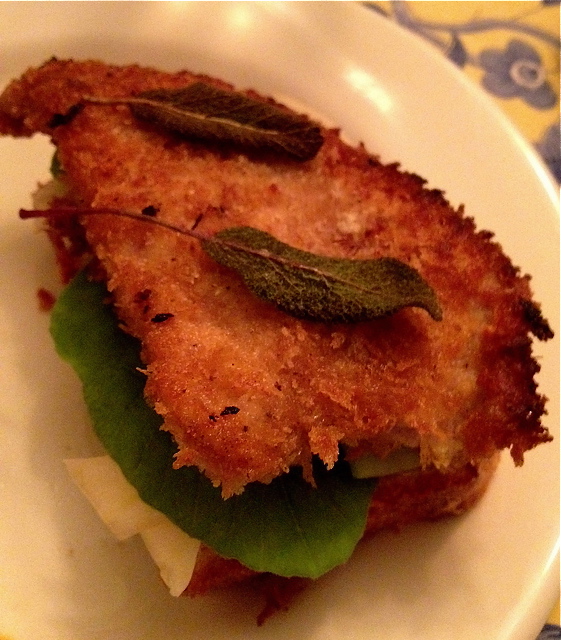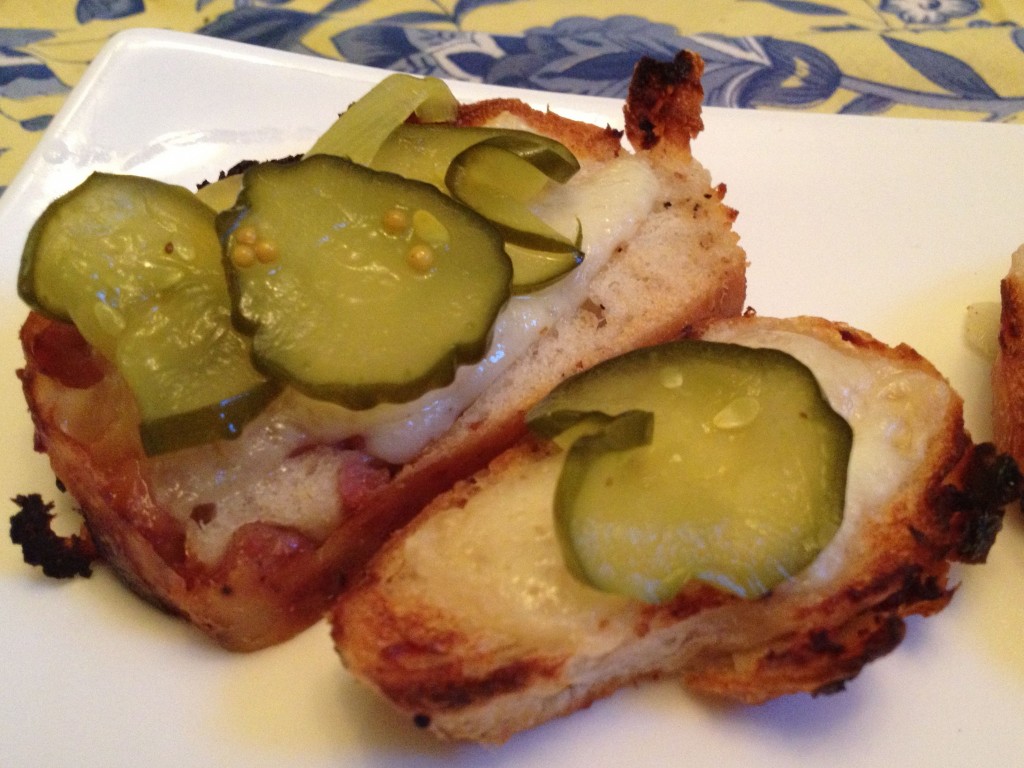Take Me to Your Liter
A chunky new kid shows up at school – what do you do? If that kid is a big 1L bottle of Grüner, you should throw an arm around its broad shoulders and call it your new best friend.

How the Hugl measures up against a bottle of Riesling
When liter-sized Grüners started showing up on wine-shop shelves, I found myself bypassing its lithe cousins, Riesling bottles, and making Grüner my go-to wine for pairing with fresh summer fare. Or any fare, for that matter. Well-made Grüner strikes the perfect balance between refreshing acidity, bright fruit and just enough weight on the palate to cause pause between gulps – few foods shun these qualities. I didn’t have to think too hard about pairing, but I wanted to have a little fun with it, fat-kid style.
To fully draw the parallel between the schoolyard events of yore, I decided to pair the 2011 Hugl Grüner Veltliner with fat-kid sandwiches, or FKS’s – a term coined by my future brother-in-law. He works at Lineage, a wonderful restaurant in Boston that bakes fresh brioche daily; whatever is leftover at the end of a night is fair game for creative staff to come up with the most decadent meals possible. Caloric intake can hit sumo levels when butter-poached lobster, cultured butter, melted leeks, chorizo and shaved Parmigiano are piled on, but it’s not hard to imagine the meteoric rise in deliciousness with every added ingredient.

Schnitzel FKS, base to top: warm brioche, whole-grain mustard, lemon-pickled fennel, peppery salad greens, schnitzel and fried sage
The cardinal rule of FKS construction I was told was that the best ones combine textures as well as flavors. So I stretched my imagination and came up with two open-faced FKS’s. To honor the wine’s Austrian roots, I made an open-faced schnitzel FKS on warm brioche. Instead of a squeeze of citrus over the top, I made lemon-pickled fennel for added crunch and puckering acidity. Spinning the globe to play with softer textures, I decided that the second brioche sandwich would be topped with seared scallops, Sriracha aioli and toasted laver, Korean seaweed perfumed with sesame oil.
Now, with a name like the fat-kid sandwich, you might imagine that your insides would feel like the San Diego fireworks fiasco. Far from it. The groans of pleasure and yummy noises heard ‘round the table and the subsequent ability of all parties to walk afterwards, signaled to me that this was a pairing well done. It may have been decadent, but guilt was far from our minds.
Golden Brioche Loaves
(Source: Dorie Greenspan “Baking: From My Home to Yours” pages 48-50)
2 packets active dry yeast
1/3 cup just-warm-to-the-touch water
1/3 cup just-warm-to-the-touch whole milk
3 3/4 cups all-purpose flour
2 teaspoons salt
3 large eggs, at room temperature
1/4 cup sugar
3 sticks (12 ounces) unsalted butter, at room temperature but still slightly firm
For The Glaze
1 large egg
1 tablespoon water

Scallop FKS, base to top: warm brioche, seared scallops, Sriracha aioli and Korean seaweed
To Make The Brioche: Put the yeast, water and milk in the bowl of a stand mixer and, using a wooden spoon, stir until the yeast is dissolved. Add the flour and salt, and fit into the mixer with the dough hook, if you have one. Toss a kitchen towel over the mixer, covering the bowl as completely as you can- this will help keep you, the counter and your kitchen floor from being showered in flour. Turn the mixer on and off a few short pulses, just to dampen the flour (yes, you can peek to see how you’re doing), then remove the towel, increase the mixer speed to medium-low and mix for a minute or two, just until the flour is moistened. At this point, you’ll have a fairly dry, shaggy mess.
Scrape the sides and bottom of the bowl with a rubber spatula, set the mixer to low and add the eggs, followed by the sugar. Increase the mixer speed to medium and beat for about 3 minutes, until the dough forms a ball. Reduce the speed to low and add the butter in 2-tablespoon-size chunks, beating until each piece is almost incorporated before adding the next. You’ll have a dough that is very soft, almost like batter. Increase the speed to medium-high and continue to beat until the dough pulls away from the sides of the bowl, about 10 minutes.
Transfer the dough to a clean bowl (or wash out the mixer bowl and use it), cover with plastic wrap and leave at room temperature until nearly doubled in size, 40 to 60 minutes, depending upon the warmth of your room.
Deflate the dough by lifting it up around the edges and letting it fall with a slap to the bowl. Cover the bowl with the plastic wrap and put it in the refrigerator. Slap the dough down in the bowl every 30 minutes until it stops rising, about 2 hours, then leave the uncovered dough in the refrigerator to chill overnight.

FKS teaser appetizer: toasted lard bread topped with melted Manchego and bread and butter pickles
The next day, butter and flour two 8 1/2-x-4 1/2-inch pans.
Pull the dough from the fridge and divide it into 2 equal pieces. Cut each piece of the dough into 4 equal pieces and roll each piece
into a log about 3 1/2 inches long. Arrange 4 logs crosswise in the bottom of each pan. Put the pans on a baking sheet lined with parchment or a silicone mat, cover the pans lightly with wax paper and leave the loaves at room temperature until the dough almost fills the pans, 1 to 2 hours. (Again, rising time with depend on how warm the room is.)
Getting Ready To Bake: Center a rack in the oven and preheat the oven to 400 degrees F.
To Make the Glaze: Beat the egg with the water. Using a pastry brush, gently brush the tops of the loaves with the glaze.
Bake the loaves until they are well risen and deeply golden, 30 to 35 minutes. Transfer the pans to racks to cool for 15 minutes, then run a knife around the sides of the pans and turn the loaves out onto the racks. Invert again and cool for at least 1 hour.
